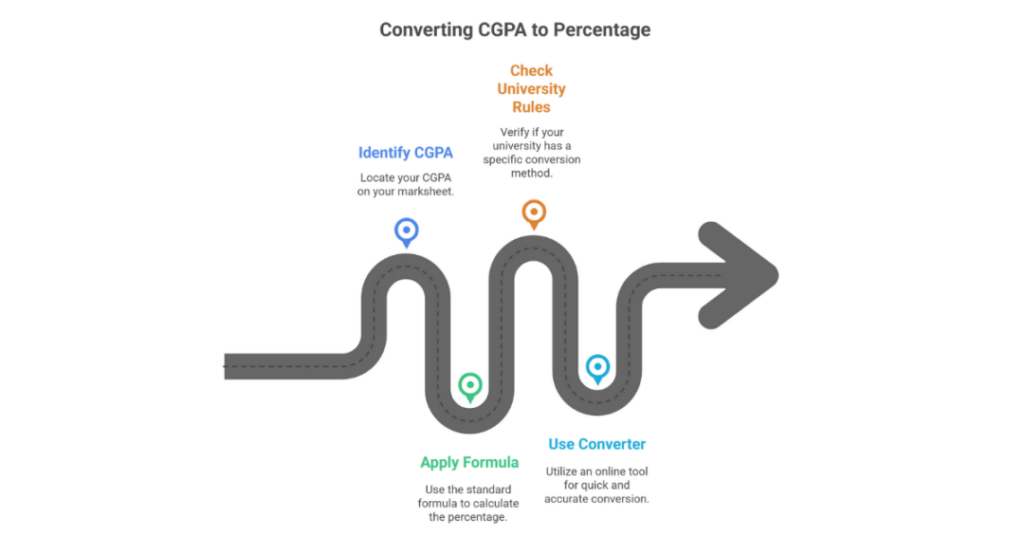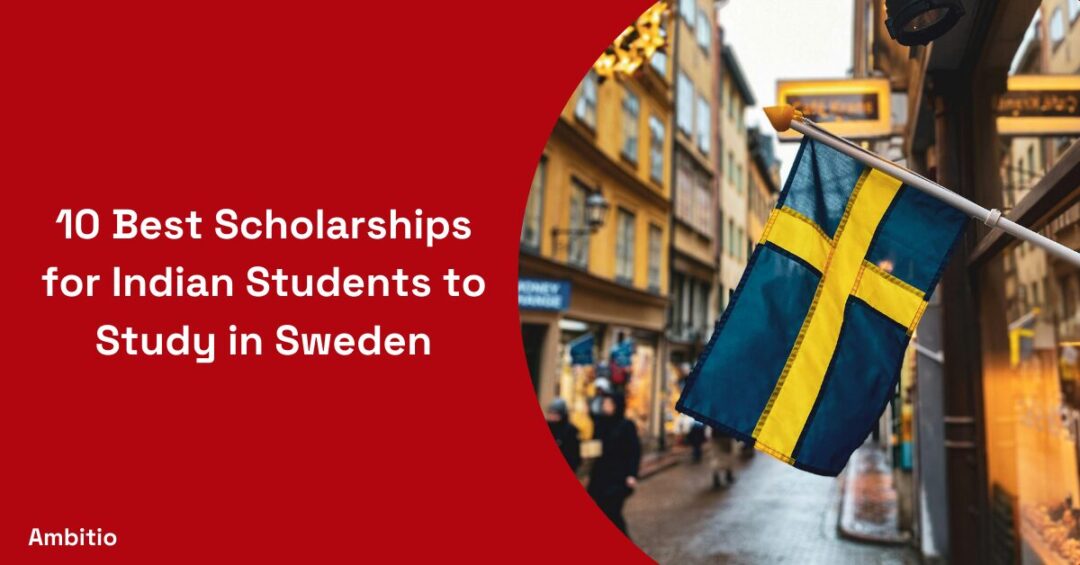22 August 2025
6 minutes read
CGPA to GPA Conversion: A Complete Guide for Indian Students

Key Takeaways
- CGPA to GPA conversion is crucial since Indian universities use a 10-point scale while most international universities rely on a 4.0 GPA scale.
- The common formula is (CGPA ÷ 10) × 4, but some universities require official evaluation or their own conversion method.
- Always check country-specific grading policies, as systems in the US, UK, Europe, and Australia vary widely.
Did you know most universities abroad don’t recognize the 10-point CGPA scale that Indian universities use, but instead rely on the 4.0 GPA scale? That’s where the real struggle begins. Students often get confused about whether to convert CGPA to GPA, use a percentage converter, or trust an online CGPA to GPA calculator.
The problem? A wrong conversion formula or GPA calculator can lower your academic performance on paper, risking your university applications. This guide helps Indian students with accurate CGPA to GPA conversion.
What is GPA?
GPA, or Grade Point Average, is a standard grading system used by universities worldwide, typically on a 4.0 scale, to measure academic performance. Unlike the 10-point CGPA scale used in Indian universities, the GPA grading system calculates grade points earned across courses.
For study abroad applications, students often need to convert CGPA to GPA using a conversion formula, GPA calculator, or CGPA to GPA converter. Accurate GPA conversion ensures universities correctly evaluate your cumulative grade point average and equivalent percentage.
What is CGPA?
CGPA stands for Cumulative Grade Point Average, is a grading system used by Indian universities, usually on a 10 point scale or 10.0 CGPA scale, to evaluate academic performance. It reflects overall grade points earned across subjects, making it easier to calculate CGPA than individual marks.
Key differences between GPA and CGPA systems
When it comes to evaluating academic performance, students often struggle to understand the distinction between GPA and CGPA. While Indian universities mostly follow the 10-point scale (10.0 scale) for CGPA calculations, international universities, especially in the US, rely on the scale of 4.0.

This leads to confusion when students need to convert CGPA to GPA for study abroad applications, requiring formulas, converters, or calculators for accurate grade conversion. Here’s a clear comparison between the two systems:
| Aspect | GPA | CGPA |
|---|---|---|
| Full Form | Grade Point Average | Cumulative Grade Point Average |
| Grading Scale | Typically on a 4.0 scale (US GPA system) | Usually a 10.0 scale used in Indian universities |
| Calculation | Based on gpa calculation of grade points earned per course | Based on CGPA calculations across all subjects |
| Usage | Universities use GPA globally, especially in the US and Europe | Indian universities mostly use CGPA for evaluation |
| Conversion | Requires cgpa conversion: e.g., cgpa to a 4-point GPA, cgpa × 9.5 for percentage, or cgpa to percentage converter | Sometimes converted into GPA using a formula to convert or online CGPA to GPA calculator |
| Flexibility | Standardized across countries (GPA in the US, Canada, etc.) | Varies between universities on a 10-point scale or CGPA by 10 points |
| Applications | Directly used in university applications abroad | Students often need to convert Indian CGPA to US GPA using equivalent GPA methods |
| Conversion Tools | GPA converter, percentage to GPA calculator, GPA to CGPA converter | Convert CGPA into a percentage using multiply the CGPA by 9.5, then adjust for grade conversion |
CGPA to GPA Conversion for Indian Students
Most Indian universities follow a 10-point CGPA system, while universities abroad, especially in the US, Canada, and Europe, use a 4.0 GPA scale. This creates confusion for students who need to convert their CGPA to GPA during study abroad applications.
The good news is: the conversion is straightforward once you understand the formulas and guidelines. Here’s a simple step-by-step guide to help you:
Step 1: Check Your CGPA
Look at your official marksheet or transcript—your CGPA will usually be mentioned on a 10-point scale.
- If your university uses percentages, convert it into CGPA using:
CGPA = Percentage ÷ 9.5
Example: 76% ÷ 9.5 = 8.0 CGPA - If your university uses a different CGPA scale (like 9 or 7):
- 9-point scale → Multiply by 1.1
- 7-point scale → Multiply by 1.43
Example: 7.5 on a 9-point scale → 7.5 × 1.1 = 8.25 on 10-point scale
Step 2: Apply the CGPA to GPA Formula
The widely accepted method to convert CGPA to GPA is:
GPA = (Your CGPA ÷ 10) × 4
Example: If CGPA = 8.2
- Divide by 10 → 8.2 ÷ 10 = 0.82
- Multiply by 4 → 0.82 × 4 = 3.28 GPA
So, 8.2 CGPA ≈ 3.28 GPA on a 4.0 scale.
Step 3: Refer to a Conversion Chart
Sometimes universities use letter grade equivalents instead of formulas. Here’s an approximate chart:
| CGPA (10 Point Scale) | GPA (4.0 Scale) | USA Grade Equivalent |
|---|---|---|
| 10.0 | 4.0 | A |
| 9.0 | 3.6 | A |
| 8.0 | 3.2 | B |
| 7.0 | 2.8 | B |
| 6.0 | 2.4 | C |
| 5.0 | 2.0 | C |
| 4.0 | 1.6 | D |
| 3.0 | 1.2 | F |
| 2.0 | 0.8 | F |
| 1.0 | 0.4 | F |
Step 4: Check University Policy
Not all universities want you to convert your grades.
- Many US/Canadian universities ask you to submit your original CGPA, and their team does the GPA calculation internally.
- Others may require evaluation by third-party agencies like WES (World Education Services) or ECE (Educational Credential Evaluators).
Always confirm with the admissions office or check the official website.
Example: Indian CGPA to US GPA Conversion
Let’s say Rohan has these semester-wise scores:
| Semester | CGPA (Out of 10) |
|---|---|
| 1 | 8.2 |
| 2 | 7.9 |
| 3 | 8.5 |
| 4 | 7.8 |
| 5 | 8.0 |
| 6 | 8.3 |
- Average CGPA = (8.2 + 7.9 + 8.5 + 7.8 + 8.0 + 8.3) ÷ 6 = 8.12
- Convert to GPA → (8.12 ÷ 10) × 4 = 3.25 GPA
Thus, Rohan’s final GPA = 3.25 on a 4.0 scale.
By using this 10-point CGPA to 4-point GPA converter formula, you can calculate GPA Score quickly and get an accurate idea of how your academic performance translates for international university applications.
How to Convert CGPA to Percentage?
Most Indian universities use the 10-point CGPA system, but many jobs and universities still ask for marks in percentage.

To make applications smooth, you often need to convert your CGPA to percentage accurately. The good news is, the process is straightforward and follows a simple formula.
Step 1: Identify Your CGPA
Check your official marksheet or transcript for your Cumulative Grade Point Average (CGPA). For example, if your CGPA is 8.0 on a 10-point scale, you’ll use this value in the calculation.
Step 2: Apply the Conversion Formula
The standard formula followed by most Indian universities (including CBSE) is:
Percentage = CGPA × 9.5
Example:
- CGPA = 8.0
- Percentage = 8.0 × 9.5 = 76%
Step 3: Check for University-Specific Rules
Some universities follow their own conversion formula. While CGPA × 9.5 is common, others may use CGPA × 10 or publish their own percentage conversion table. Always confirm from your university’s official grading system.
Step 4: Use a CGPA to Percentage Converter
If you want quick results, you can use an online CGPA to percentage converter or a calculator. Just enter the CGPA, and the tool helps you find the percentage instantly with an accurate conversion.
Example Conversion Chart (10-Point CGPA to Percentage)
| CGPA | Percentage |
|---|---|
| 10.0 | 95% |
| 9.0 | 85.5% |
| 8.0 | 76% |
| 7.0 | 66.5% |
| 6.0 | 57% |
| 5.0 | 47.5% |
In short, the most common way to convert CGPA to percentage is to multiply your CGPA by 9.5. This simple formula ensures your academic performance is represented accurately for university applications and job opportunities.
Country-Specific Requirements for CGPA to GPA Conversion
While the basic formula to convert CGPA from GPA works as a guideline, each country (and sometimes each university) follows its own grading scale and conversion method.
To avoid errors in your university applications, it’s important to understand these country-specific expectations.
| Country | Grading System Used | Conversion Requirement | Notes for Indian Students |
|---|---|---|---|
| USA | 4.0 GPA scale | Many universities ask for transcripts as-is; some require (CGPA ÷ 10) × 4 formula or third-party evaluations (e.g., WES, ECE). | Always check if the university requires self-conversion or official credential evaluation. |
| Canada | 4.0 or 4.3 GPA scale | Universities may accept CGPA × 9.5 = Percentage, then convert to GPA internally. | Some schools directly use percentages; others ask for WES evaluation. |
| UK | Class-based grading (First, 2:1, 2:2, Third) | CGPA is often converted to a percentage first, then matched with UK classes. | For example, 60%+ = 2:1; 70%+ = First Class. |
| Australia | 7-point GPA scale | Students may need to convert Indian CGPA to percentage first, then map to the Australian GPA. | Example: 85%+ = 7 GPA (High Distinction). |
| Europe (Germany, France, etc.) | Varies: often a 5 or 10-point scale | Universities usually have their own grade conversion chart. | German universities often use the Bavarian formula for accurate conversion. |
| Dubai & Middle East | Mix of 4.0 GPA scale and percentage systems | Typically accept direct percentage conversion from CGPA using × 9.5. | Some institutions follow US-style GPA rules. |
How to Convert 10 Point CGPA to 4 Point GPA for European Universities?
Unlike the US GPA system, most European universities don’t follow a universal 4.0 scale. Instead, countries like Germany, France, and Italy often use their own grading systems (such as the German 5-point scale or the ECTS system).
However, when applying to programs that ask for a 4.0 GPA equivalent, you can follow a standard approach.
Step 1: Start with Your CGPA on a 10-Point Scale
Check your transcript from your Indian university.
Example: CGPA = 8.0 (on a 10-point scale).
Step 2: Convert CGPA to Percentage
Use the standard Indian formula:
Percentage = CGPA × 9.5
Example: 8.0 × 9.5 = 76%.
Step 3: Apply the 10-Point CGPA to 4-Point GPA Formula
Now convert your CGPA to GPA using:
GPA = (CGPA ÷ 10) × 4
Example: (8.0 ÷ 10) × 4 = 3.2 GPA.
Step 4: Check Country-Specific Conversion Methods
- Germany: Uses the Bavarian Formula instead of the simple CGPA to GPA method.
- France & Italy: Often rely on percentage-based equivalence rather than GPA.
- Netherlands & Scandinavia: Accept transcripts and may use their own grade conversion internally.
Example Conversion Chart (10-Point CGPA → 4-Point GPA for Europe)
| CGPA (India, 10-point) | Percentage (× 9.5) | Approx. GPA (4.0 Scale) |
|---|---|---|
| 10.0 | 95% | 4.0 |
| 9.0 | 85.5% | 3.6 |
| 8.0 | 76% | 3.2 |
| 7.0 | 66.5% | 2.8 |
| 6.0 | 57% | 2.4 |
| 5.0 | 47.5% | 2.0 |
Important Note
European universities often do not require students to convert their CGPA themselves. Many ask you to submit official transcripts, and they use their own conversion formula or ECTS grading scale. Always verify with the admissions office before applying.
Conclusion
Converting CGPA to GPA may look simple on paper, but every university abroad has its own grading scale and conversion policy. A small mistake in calculating your academic performance can weaken your application, even if you have a strong profile. That’s where Ambitio steps in.
At Ambitio, we don’t just help you with accurate CGPA to GPA conversion. We specialize in complete profile building, application strategy, and study abroad guidance. If you’re serious about your dream university, let’s build your future together. Ready to stand out? Book a free consultation with Ambitio today!
FAQs
Can I convert a 10-point CGPA to a 4-point GPA by simple division?
No, the conversion isn’t as simple as dividing by a factor. It requires understanding the equivalence of grades in both systems.
Are online CGPA to GPA converters accurate?
While they provide a general idea, it’s best to check with the academic institution for precise conversion criteria.
Why is it important to convert CGPA for studying abroad?
Different countries use different grading scales. Converting your CGPA to the prevalent GPA system in the destination country is essential for university applications.
Does a high CGPA guarantee a high GPA after conversion?
Not necessarily. The conversion depends on the grading criteria and course rigor in the original CGPA system.
Where can I get official CGPA to GPA conversion documents?
You should request CGPA to GPA conversion documentation from your university or credential evaluation agencies.
Does CGPA to GPA conversion affect admission chances?
Accurate CGPA to GPA conversion ensures your grades are correctly interpreted, which can impact eligibility for certain programs.
What scales are used in CGPA to GPA conversion?
CGPA is often on a 10-point scale, while GPA usually uses a 4-point scale, which is a key factor in CGPA to GPA conversion.

You can study at top universities worldwide!
Get expert tips and tricks to get into top universities with a free expert session.
Book Your Free 30-Minute Session Now! Book a call now




























